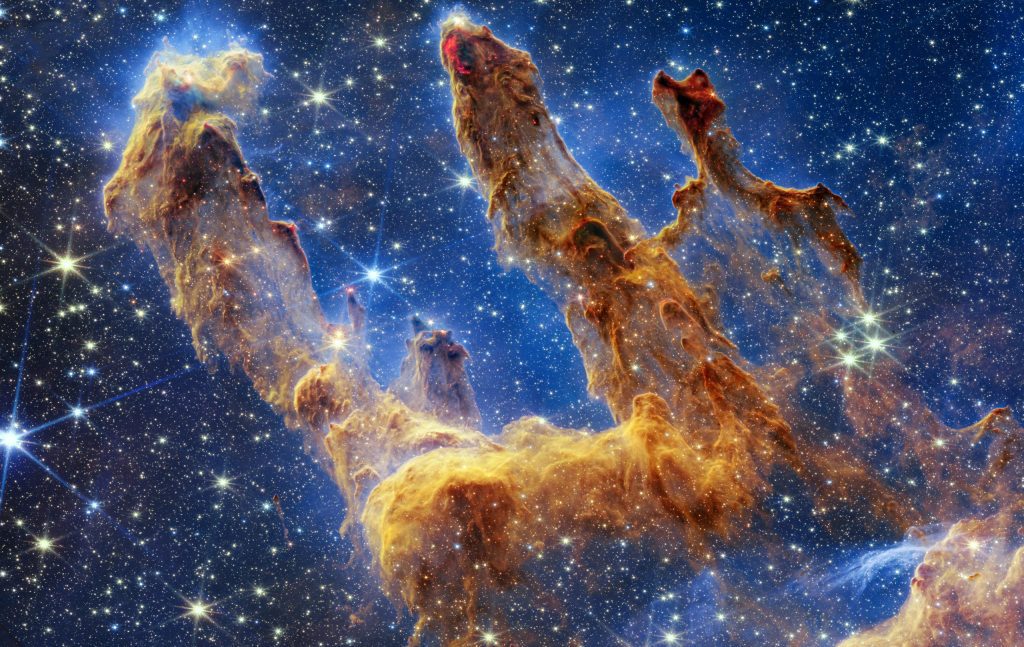
Cahaya inframerah dekat mengungkapkan konstelasi besar bintang-bintang penyusunnya, banyak di antaranya masih dikelilingi oleh debu
James Webb Space Telescope’s Near-Infrared Camera captured this glittering view of the Pillars of Creation – and it begs to be examined pixel by pixel. It is a stunning scene that may look both familiar and entirely new at the same time. It was first captured by NASA’s Hubble Space Telescope in 1995 and followed up in 2014, and many other telescopes have deeply gazed at this scene. However, this is the first time an observatory has delivered such detailed data in near-infrared light. Newly formed stars pop out in shades of pink, red, and crimson. Still-forming stars that remain hidden deep in dusty pillars resemble molten lava, and fully-formed blue and yellow stars sprinkle the scene.
Where are the galaxies that often “photobomb” Webb’s images? The pillars are located directly in front of our Milky Way galaxy’s disk, which blocks our view of the galaxies that lie behind it. It is also lit up by the collective light from the packed “party” of stars. With these new data, researchers will be able to update complex models of star formation with even more precise star counts and dust quantities. It is clear that we are about to learn a whole lot more about how stars form.

The Pillars of Creation are set off in a kaleidoscope of color in NASA’s James Webb Space Telescope’s near-infrared-light view. The pillars look like arches and spires rising out of a desert landscape, but are filled with semi-transparent gas and dust, and ever-changing. This is a region where young stars are forming – or have barely burst from their dusty cocoons as they continue to form. Credit: NASA, ESA, CSA, STScI; Joseph DePasquale (STScI), Anton M. Koekemoer (STScI), Alyssa Pagan (STScI).
NASA’s Webb Takes Star-Filled Portrait of Pillars of Creation
In exquisite detail, NASA’s James Webb Space Telescope has captured a lush, intricate landscape – the iconic Pillars of Creation. This is a region where new stars are forming within dense clouds of gas and dust. The three-dimensional pillars resemble majestic rock formations, but are far more permeable. These columns are made up of cool interstellar gas and dust that appear – at times – semi-transparent in near-infrared light.
Webb’s new view of the Pillars of Creation, which were first made famous when imaged by NASA’s Hubble Space Telescope in 1995, will help astronomers revamp their models of star formation by identifying far more precise counts of newly formed stars, along with the quantities of gas and dust in the region. Over time, they will begin to build a clearer understanding of how stars form and burst out of these dusty clouds over millions of years.

NASA’s Hubble Space Telescope made the Pillars of Creation famous with its first image in 1995, but revisited the scene in 2014 to reveal a sharper, wider view in visible light, shown above at left. A new, near-infrared-light view from NASA’s James Webb Space Telescope, at right, helps us peer through more of the dust in this star-forming region. The thick, dusty brown pillars are no longer as opaque and many more red stars that are still forming come into view. Credit: NASA, ESA, CSA, STScI; Joseph DePasquale (STScI), Anton M. Koekemoer (STScI), Alyssa Pagan (STScI).
Newly formed stars are the scene-stealers in this stunning image from Webb’s Near-Infrared Camera (NIRCam). These are the bright red orbs that typically have diffraction spikes and lie outside one of the dusty pillars. When knots with sufficient mass form within the pillars of gas and dust, they begin to collapse under their own gravity, slowly heat up, and eventually form new stars.
What about those wavy lines that look like lava at the edges of some pillars? These are ejections from stars that are still forming within the gas and dust. Young stars periodically shoot out supersonic jets that collide with clouds of material, like these thick pillars. This sometimes also results in bow shocks, which can form wavy patterns like a boat does as it moves through water. The crimson glow comes from the energetic hydrogen molecules that result from jets and shocks. This is evident in the second and third pillars from the top – the NIRCam image is practically pulsing with their activity. These young stars are estimated to be only a few hundred thousand years old.
Ikuti tur video pandangan inframerah dekat Webb dari Pilar Penciptaan. Kredit: NASA, ESA, CSA, STScI; Joseph DePasquale (STScI), Anton M. Coquemore (STScI), Alyssa Pagan (STScI); Daniel Kirchenblatt (STScI).
Meskipun mungkin tampak bahwa cahaya inframerah-dekat memungkinkan Webb untuk “menembus” awan untuk mengungkapkan jarak kosmik yang jauh di belakang gumpalan, tidak ada galaksi dalam pandangan ini. Sebaliknya, campuran gas dan debu transparan yang dikenal sebagai medium antarbintang di bagian terpadat cakram Bima Sakti mengaburkan pandangan kita tentang alam semesta terdalam. (Media antarbintang adalah gas dan debu yang tersebar di antara bintang-bintang galaksi. Ini terutama terdiri dari atom hidrogen, molekul, dan partikel debu padat.)
Adegan ini pertama kali difilmkan oleh Hubble pada tahun 1995 Dan Direvisi pada tahun 2014, tetapi banyak observatorium lain yang menatap jauh ke dalam area ini. Setiap alat canggih menawarkan penyelidik detail baru tentang wilayah ini, yang praktis dipenuhi bintang.
Gambar yang dipotong ini ditempatkan dengan rapat di dalam Nebula Elang yang luas, yang berjarak 6.500 tahun cahaya.
Itu Teleskop Luar Angkasa James Webb Apakah kamu Teleskop luar angkasa paling kuat yang pernah dibuat dan Observatorium sains luar angkasa pertama di dunia. Itu akan Memecahkan Teka-teki Di tata surya kita, lihat lebih jauh Dunia jauh di sekitar bintang lainjelajahi struktur misterius dan Asal usul alam semesta kita Dan di mana kita berada. Webb adalah program internasional yang dipimpin oleh NASA dengan mitranya, ESA (Badan Antariksa Eropa) dan CSA (Badan Antariksa Kanada).

“Geek tv yang sangat menawan. Penjelajah. Penggemar makanan. Penggemar budaya pop yang ramah hipster. Guru zombie seumur hidup.”





/cdn.vox-cdn.com/uploads/chorus_asset/file/24931352/236792_iPhone_15_Pro_and_15_Pro_Max_product_photos_AJohnson_0008.jpg)
More Stories
Jejak kaki dinosaurus yang identik ditemukan di dua benua
Kapan para astronot akan diluncurkan?
Perjalanan seorang miliarder ke luar angkasa “berisiko”